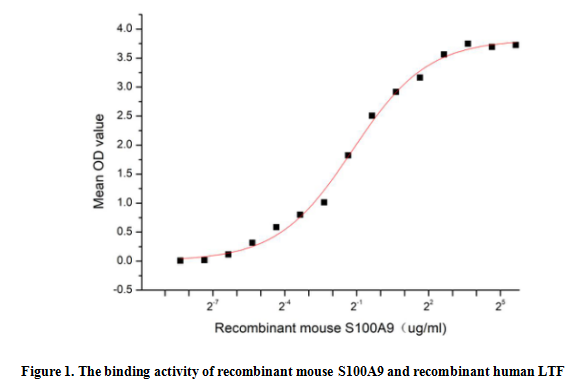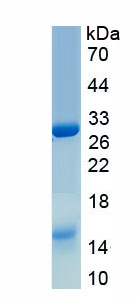Active S100 Calcium Binding Protein A9 (S100A9) 

MRP14; MIF; 60B8AG; CFAG; NIF; CAGB; CGLB; L1AG; P14; Calgranulin B; Migration inhibitory factor-related protein 14; Calprotectin L1H subunit; Leukocyte L1 complex heavy chain
Overview
Properties
- Product No.APB793Mu01
- Organism SpeciesMus musculus (Mouse) Same name, Different species.
- ApplicationsCell culture; Activity Assays.
Research use only - DownloadInstruction Manual
- CategoryTumor immunityInfection immunityRheumatology
- Buffer FormulationPBS, pH7.4, containing 0.01% SKL, 5% Trehalose.
- Traits Freeze-dried powder, Purity > 80%
- Isoelectric Point6.9
Sign into your account
Share a new citation as an author
Upload your experimental result
Review

Contact us
Please fill in the blank.
Activity test

S100 calcium-binding protein 9 (S100A9) also known as calgranulin B, is a member of the S100 family of secreted calcium binding proteins containing 2 EF-hand calcium-binding motifs. S100 proteins are localized in the cytoplasm and/or nucleus of a wide range of cells, and involved in the regulation of a number of cellular processes such as cell cycle progression and differentiation. Lactoferrin (LTF) is one of targets of S100A9, thus a functional binding ELISA assay was conducted to detect the interaction of recombinant mouse S100A9 and recombinant human LTF. Briefly, S100A9 was diluted serially in PBS with 0.01% BSA (pH 7.4). Duplicate samples of 100 μl were then transferred to LTF-coated microtiter wells and incubated for 1h at 37℃. Wells were washed with PBST and incubated for 1h with anti-S100A9 pAb, then aspirated and washed 3 times. After incubation with HRP labelled secondary antibody for 1h at 37℃, wells were aspirated and washed 5 times. With the addition of substrate solution, wells were incubated 15-25 minutes at 37℃. Finally, add 50 µL stop solution to the wells and read at 450/630 nm immediately. The binding activity of recombinant mouse S100A9 and recombinant human LTF was shown in Figure 1, the EC50 for this effect is 0.44 ug/mL.
Usage
Reconstitute in 10mM PBS (pH7.4) to a concentration of 0.1-1.0 mg/mL. Do not vortex.
Storage
Avoid repeated freeze/thaw cycles. Store at 2-8°C for one month. Aliquot and store at -80°C for 12 months.
Stability
The thermal stability is described by the loss rate. The loss rate was determined by accelerated thermal degradation test, that is, incubate the protein at 37°C for 48h, and no obvious degradation and precipitation were observed. The loss rate is less than 5% within the expiration date under appropriate storage condition.
Increment services
-
 BCA Protein Quantification Kit
BCA Protein Quantification Kit
-
 Molecular Mass Marker for Protein
Molecular Mass Marker for Protein
-
 Monoclonal Antibody Customized Service
Monoclonal Antibody Customized Service
-
 Polyclonal Antibody Customized Service
Polyclonal Antibody Customized Service
-
 Protein Activity Test Experiment Service
Protein Activity Test Experiment Service
-
 Electrophoretic Mobility Shift Assay (EMSA) Experiment Service
Electrophoretic Mobility Shift Assay (EMSA) Experiment Service
-
 Buffer
Buffer
-
 Lentivirus Packaging Experiment Service
Lentivirus Packaging Experiment Service
-
 Adenovirus Packaging Experiment Service
Adenovirus Packaging Experiment Service
-
 Real Time PCR Experimental Service
Real Time PCR Experimental Service
-
 Spike RBD Protein (S-RBD)
Spike RBD Protein (S-RBD)
-
 Protein G
Protein G
-
 Protein A
Protein A
Citations
- Differential Proteomic Analysis Distinguishes Tissue Repair Biomarker Signatures in Wound Exudates Obtained from Normal Healing and Chronic WoundsPubmed: source
- High circulating levels of S100A8/A9 complex (calprotectin) in male Japanese with abdominal adiposity and dysregulated expression of S100A8 and S100A9 in adipose tissues of obese miceScienceDirect: S0006291X1200352X
- Proteins with Altered Levels in Plasma from Glioblastoma Patients as Revealed by iTRAQ-Based Quantitative Proteomic AnalysisPubMed: 23029420
- Identifizierung neuer potentieller Biomarker für das Kolonkarzinom sowie dessen VorstufenInfo:Source
- Susceptibility to COPD: Differential Proteomic Profiling after Acute SmokingPubmed:25036363
- Soluble receptor for advanced glycation end products inhibits disease progression in autosomal dominant polycystic kidney disease by down-regulating cell proliferationPubMed: 25934702
- S100A9 and ORM1 serve as predictors of therapeutic response and prognostic factors in advanced extranodal NK/T cell lymphoma patients treated with pegaspargase/gemcitabinepmc:PMC4810364
- Proteomics Analysis of Blood Serums from Alzheimer's Disease Patients Using iTRAQ LabelingTechnology.pubmed:27911324
- Immune Modulating Topical S100A8/A9 Inhibits Growth of Pseudomonas aeruginosa and Mitigates Biofilm Infection in Chronic Wounds.pubmed:28672877
- Tu1938-Micronutrients Assessment in Patients with Cirrhosis10.1016:S0016-5085(18)33544-3
- Tu1942-PI3K/AKT-Mediated Upregulation of C7 Inhibits Colorectal Cancer Proliferation and Metastasis10.1016:S0016-5085(18)33544-5
- Signaling between pancreatic β-cells and macrophages via S100 calcium-binding protein A8 exacerbates β-cell apoptosis and islet inflammationPubmed:29496993
- The role of calgranulin B gene on the biological behavior of squamous cervical cancer in vitro and in vivoPubmed:29497331
- S100A8/A9 promotes MMP-9 expression in the fibroblasts from cardiac rupture after myocardial infarction by inducing macrophages secreting TNFα.Pubmed:29949169
- Estudio de células inmunosupresoras y biomarcadores circulantes en carcinoma renal
- Mass Spectrometry Analysis of the Exhaled Breath Condensate and Proposal of Dermcidin and S100A9 as Possible Markers for Lung Cancer PrognosisPubmed: 31115649
- 降钙素原, 超敏C 反应蛋白, 红细胞沉降率及S100A9 对肺结核合并肺部细菌感染的影响
- Serum S100A6, S100A8, S100A9 and S100A11 proteins in colorectal neoplasia: results of a single centre prospective studyPubmed: 31856598
- Adverse reproductive effects of S100A9 on bovine sperm and early embryonic development in vitroPubmed: 31945120
- Overexpression of S100A9 in tumor stroma contribute to immune evasion of NK/T cell lymphoma and predict poor response rate34045609
- Adjunctive S100A8/A9 Immunomodulation Hinders Cipro fl oxacin Resistance in







